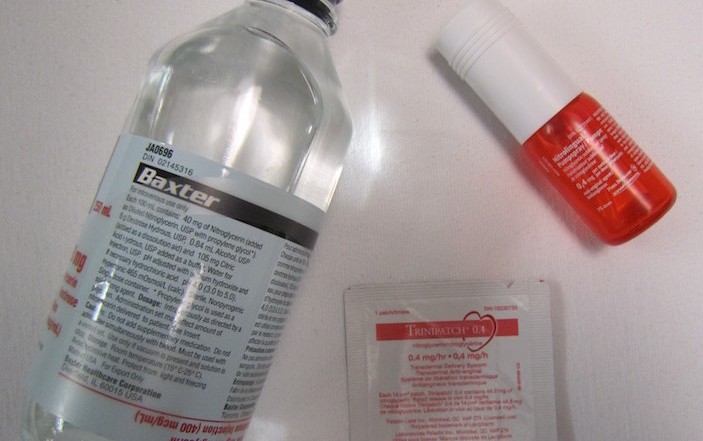Though first used in explosives, nitroglycerin (NTG) is now a key drug for treatment of angina, acute MI, and decompensated heart failure.
Major Indications:
NTG is FDA-approved for indications as diverse as the treatment of angina and of anal fissures. It is also routinely used off-label for treatment of acute decompensated heart failure (ADHF), and for acute coronary syndromes (ACS).1 Other off-label uses include the treatment of extravasation of vasopressors, for esophageal spastic disorders, and hemorrhage from esophageal varices.
How It Works:
NTG is converted to nitric oxide in the mitochondria. Nitric oxide activates guanylate cyclase, which ultimately leads to relaxation of smooth muscle, and vasodilation. For the purposes of pulmonary edema in ADHF, vasodilation leads to reduced preload, and therefore lower pressures in the pulmonary arteries. For angina, it dilates coronary arteries, and thereby improves myocardial oxygen delivery, and also reduces left ventricular filling pressures. At high doses it can also reduce afterload. For anal fissures, the nitric oxide helps relax the smooth muscle of the anal sphincters
Notable History:
NTG was first manufactured for use as an explosive, and has been used as such since the 1860s. Prohibitions on its storage as a liquid led to Alfred Nobel developing dynamite, in 1867. Nitroglycerin’s medical use began in the late 1870s. In 2002 it was discovered that mitochondrial aldehyde dehydrogenase was responsible for the release of the biologically active nitric oxide from NTG.2 The earliest available publication on nitroglycerin in Medline dates back to 1910, in a paper that declares: “The results obtained show that adrenalin, transfusion with salt solution, and the inhalation of tobacco smoke caused an increased circulation in the coronary vessels. Amyl nitrite and nitroglycerin produce the opposite effect.”3 Ironically, nitroglycerin is now used precisely for its ability to improve coronary artery blood flow.
Recently In The News For:
Right ventricular infarction accompanies inferior MIs in about 30-40% of cases. Conventional wisdom states that use of NTG in inferior MIs therefore carries the theoretical risk of hypotension if the infarct also involves the right ventricle. However, pre-hospital EKG analysis does not differentiate STEMI anatomical location prior to initiation of NTG therapy. A recent retrospective study on prehospital administration of nitroglycerin for STEMI found that there was no significant difference in the rates of hypotension after NTG was given to patients with inferior STEMIs (8.2%) and non-inferior STEMIs (8.9%).4 More work is needed in this area, but this study can alleviate some of the concern about giving NTG to STEMI patients without anatomical localization of the STEMI based on the EKG.
Adverse Events:
Nitroglycerin will predictably cause a drop in blood pressure, so when ordering it with repeat doses, hold parameters should be placed so that it is not administered when the blood pressure is low. The AHA recommends against using NTG if the systolic BP is <90, or if it is more than 30 points below the patient’s baseline.5 NTG should also be used with caution in patients with bradycardia <50 or tachycardia >100 in the absence of heart failure.
Cautions:
Think twice before using NTG in a patient who is pre-load dependent, as their blood pressure could drop precipitously. This includes patients with pulmonary emboli, right ventricular infarctions, hypertrophic cardiomyopathy, and aortic stenosis. NTG is class C in pregnancy. In breastfeeding mothers, it is not clear how much of the drug is present in breast milk.6 Mothers should discard expressed milk to be safe.
Dosing & Adjustments:
For use in patients with angina or ACS, treatment is typically sublingual with a tablet or spray of 0.3-0.4mg every 5 minutes for 3 doses. In patients with ADHF, NTG is titrated IV with rates of 10-200mcg/min (some sources say up to 500mcg/min). While a dose of 400 or 500 micrograms/min of IV NTG seems high, remember that a sublingual dose of 0.4mg = 400 micrograms. Bioavailability of sublingual NTG is reported at about 40%, but varies a lot, with peak effect at about 5 minutes. Intravenous NTG is effective immediately. Topical NTG ointment provides peak plasma NTG concentrations at 1-2 hours, but bioavailability of topical NTG is only about 50%.
Cost:
Sublingual NTG costs about $15 for 25 0.4mg tablets. The translingual sprays cost about $225 for a 4.1g vial that will deliver 10 sprays of 0.4mg each. IV NTG in D5W costs around $8 for 250mL of the 100mcg/mL solution.1 The cost of 100 patches of Topical NTG ointment 0.4mg varies, but is around $80 retail.
REFERENCES
- Lexicomp Online. Nitroglycerin (glyceryl trinitrate): Drug information. www.uptodate.com. Accessed 06/01, 2015.
- Chen Z, Foster MW, Zhang J, et al. An essential role for mitochondrial aldehyde dehydrogenase in nitroglycerin bioactivation. Proc Natl Acad Sci U S A. 2005;102(34):12159-12164.
- Bond GS. Effect of various agents on the blood flow through the coronary arteries and veins. J Exp Med. 1910;12(5):575-585.
- Robichaud L, Ross D, Proulx MH, et al. Prehospital nitroglycerin safety in inferior ST elevation myocardial infarction. Prehosp Emerg Care. 2015.
- Anderson JL, Adams CD, Antman EM, et al. 2012 ACCF/AHA focused update incorporated into the ACCF/AHA 2007 guidelines for the management of patients with unstable angina/non-ST-elevation myocardial infarction: A report of the american college of cardiology foundation/american heart association task force on practice guidelines. Circulation. 2013;127(23):e663-828.
- Hale TW. Medications and mothers’ milk: A manual of lactational pharmacology. 12th ed. Amarillo, TX: Hale Publishing L.P.; 2012:1331.
Photo by James Heilman, MD




1 Comment
Thank you. One typo: NTG spray, 4.9 gram delivers 400 mcg dose per spray with 60 sprays per container, contract prices vary, ~$150 per bottle at my facility.